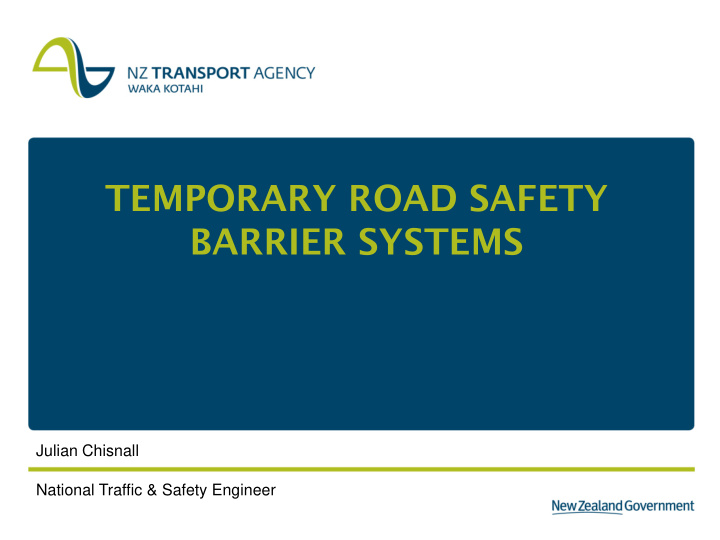



TEMPORARY ROAD SAFETY BARRIER SYSTEMS Julian Chisnall National Traffic & Safety Engineer
Overview Performance and Specification (NZTA M23) • Overview of available systems • Selection criteria • ‘What Not To Do’ • Reference Documents •
Performance: Testing protocol System performance is determined through full-scale • crash testing and evaluation of results 3 commonly used testing protocols: • • FHWA - NCHRP Report 350 (1993) • Europe - EN1317 (1998) • AASHTO - MASH (2009) • All 3 protocols use “standard” test vehicles
820C vs 1100C (Light Cars) 1993 Chevrolet (Geo) Metro 2003 Kia Rio (NCHRP350) (MASH)
2000P vs 2270P (Pick up trucks) 1993 Chevrolet Silverado 2500 2003 Dodge Ram (NCHRP350) (MASH)
Are these changes relevant to NZ ? • 1993 Toyota Corolla: kerb weight – 1075kg • 2012 Hyundai i30 hatch: kerb weight – 1377kg • 1993 Toyota Hilux double cab 4x4 • Kerb weight – 1630kg • Gross weight – 2730kg • 2012 Ford Ranger double cab 4x4 • Kerb weight 1964kg • Gross weight 3200kg 41% more than a MASH TL3 test vehicle (2270kg) !!
So…from 1 November 2012 • All new road safety hardware systems and any significant variants of existing systems must be tested to MASH for acceptance by NZ Transport Agency • Existing NCHRP350 systems “grandfathered” • They still comply • They can still be sold • They can still be installed • Promo material must use MASH performance data (if available)
Specification M23 • Gives the performance requirements for state highway road safety barriers, terminals and crash cushions • Details the systems accepted for installation • May be used by local authorities • Currently being reviewed and expanded to cover Permanent barriers (Appendix A) • Bridge barriers (Appendix B) • Temporary barriers (Appendix C) • Interim Acceptances •
Temporary Road Safety Barrier Systems
Plastic Water-Filled Barriers Probably the most common temporary barrier type on NZ roads • Tested up to TL2 (70km/h) or TL3 (100km/h) • Reasonably forgiving on vehicle occupants • Significant deflection, up to approx. 2m • “System” – have an integral end terminal (Yellow) and barrier units (orange)
Plastic Water-Filled Barriers Ricochet ArmorZone Sentry + SLED
Plastic Water-Filled Barriers
Temporary Concrete/Steel Barriers Concrete - Very common temporary barrier type Steel – has an increasing presence • Tested up to TL3 (100km/h) • Some meet TL4 when pinned to pavement • Only Semi-Rigid (unlike permanent concrete systems) • Less forgiving on vehicle occupants • Moderate Deflection (up to 1.5m unpinned) • Both proprietary and public domain joint systems • Barrier only – require a suitable crash cushion
Temporary Concrete/Steel Barriers F-Shape Concrete BarrierGuard BG800
Temporary Concrete/Steel Barriers
Crash Cushions Quadguard CZ X-TENuator ABSORB 350
Crash Cushions: sacrificial “water filled”
Crash Cushions: sacrificial “mechanical”
Crash Cushions: re-usable
No Crash Cushion ??
Temporary System Selection CoPTTM (4th edition, section C18) requires that: “The selected system or component must have complied with a test level that meets or exceeds the operating speed of adjacent traffic. The speed value used to determine the required barrier performance level must be the highest likely impact speed.” So….Unattended SH site + temp 70km/h @ 3:30am = Test Level 2 ….. Right ? Maybe, maybe not
Crash Cushion Selection Need to ensure most appropriate crash cushion chosen ( VERY ) Indicative criteria at this stage: • Traffic Volumes • Permanent Posted Speed Limit • Proposed Duration of Works • Number of “Live” Lanes Combine into a simple guide, giving………
Crash Cushion Selection Water Filled Crash Cushion Sacrificial Steel System or Plate Mounted Permanent System Permanent System (Installed at temporary location)
Temporary Road Safety Barriers: Issues Always remember these are engineered systems • Use only “accepted” systems listed in M23 or has an Interim Acceptance • • Don’t change or modify any component makes the system non-compliant and potentially hazardous • • Always follow manufacturers installation instructions they designed it ! • • Must have a terminal at each end otherwise its not a system ! •
Water filled barriers should be…filled !!
Barrier units need to be joined to work !!
The pins are provided for a reason !!
Don’t mix and match systems !
Crash cushions need to be connected
Reference Documents • NZTA Technical Advice website Technical Memoranda “Road Safety Hardware Series” • NZTA M23:Specification for Road Safety Barrier Systems • (currently under review) http://www.nzta.govt.nz/network/technical/hardware/index.html • External Documents: AASHTO Manual for Assessing Safety Hardware (MASH) • Austroads Guide to Road Design Part 6 •
Questions ?? Contact me: Julian Chisnall National Traffic & Safety Engineer Highways & Network Operations P 04 894 6194 E julian.chisnall@nzta.govt.nz
Recommend
More recommend